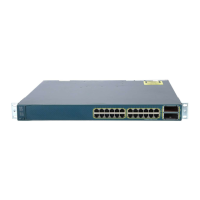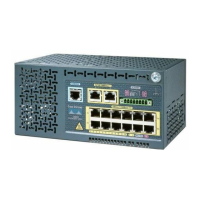34-2
Catalyst 3750 Switch Software Configuration Guide
78-16180-02
Chapter 34 Configuring IP Unicast Routing
Understanding IP Routing
Understanding IP Routing
In some network environments, VLANs are associated with individual networks or subnetworks. In an
IP network, each subnetwork is mapped to an individual VLAN. Configuring VLANs helps control the
size of the broadcast domain and keeps local traffic local. However, network devices in different VLANs
cannot communicate with one another without a Layer 3 device (router) to route traffic between the
VLAN, referred to as inter-VLAN routing. You configure one or more routers to route traffic to the
appropriate destination VLAN.
Figure 34-1 shows a basic routing topology. Switch A is in VLAN 10, and Switch B is in VLAN 20. The
router has an interface in each VLAN.
Figure 34-1 Routing Topology Example
When Host A in VLAN 10 needs to communicate with Host B in VLAN 10, it sends a packet addressed
to that host. Switch A forwards the packet directly to Host B, without sending it to the router.
When Host A sends a packet to Host C in VLAN 20, Switch A forwards the packet to the router, which
receives the traffic on the VLAN 10 interface. The router checks the routing table, finds the correct
outgoing interface, and forwards the packet on the VLAN 20 interface to Switch B. Switch B receives
the packet and forwards it to Host C.
This section contains information on these routing topics:
• Types of Routing, page 34-2
• IP Routing and Switch Stacks, page 34-3
Types of Routing
Routers and Layer 3 switches can route packets in three different ways:
• By using default routing
• By using preprogrammed static routes for the traffic
• By dynamically calculating routes by using a routing protocol
Default routing refers to sending traffic with a destination unknown to the router to a default outlet
or destination.
Static unicast routing forwards packets from predetermined ports through a single path into and out of a
network. Static routing is secure and uses little bandwidth, but does not automatically respond to changes
in the network, such as link failures, and therefore, might result in unreachable destinations. As networks
grow, static routing becomes a labor-intensive liability.
18071
A
B
C
Host
Host
Host
Switch A Switch B
VLAN 10 VLAN 20
ISL Trunks
